Yamaha TTR50 Manual

OWNER’S MANUAL MANUEL DU PROPRIÉTAIRE BEDIENUNGSANLEITUNG
TT-R50E
TT-R50EW
1P6-F8199-81
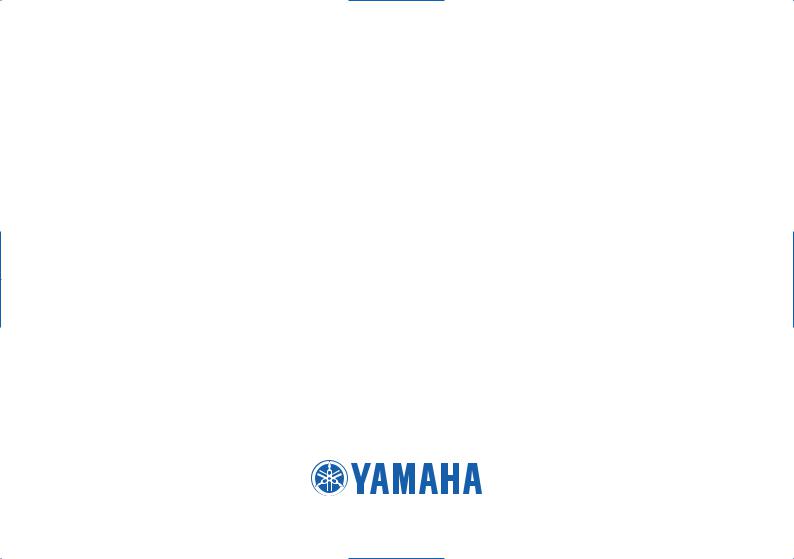
YAMAHA MOTOR CO., LTD.
PRINTED IN CHINA
2006.04-0.3×1 CR (E,F,G)

OWNER’S MANUAL
TT-R50E
TT-R50EW
1P6-F8199-81-E0

INTRODUCTION
EAU41800
Congratulations on your purchase of the Yamaha TT-R50E/TT-R50EW. This model is the result of Yamaha’s vast experience in the production of fine sporting, touring, and pacesetting racing machines. It represents the high degree of craftsmanship and reliability that have made Yamaha a leader in these fields.
This manual will give you an understanding of the operation, inspection, and basic maintenance of this motorcycle. If you have any questions concerning the operation or maintenance of your motorcycle, please consult a Yamaha dealer.
The design and manufacture of this Yamaha motorcycle fully comply with the emissions standards for clean air applicable at the date of manufacture. Yamaha has met these standards without reducing the performance or economy of operation of the motorcycle. To maintain these high standards, it is important that you and your Yamaha dealer pay close attention to the recommended maintenance schedules and operating instructions contained within this manual.
AN IMPORTANT SAFETY MESSAGE:
●READ THIS MANUAL COMPLETELY BEFORE OPERATING YOUR MOTORCYCLE. MAKE SURE YOU UNDERSTAND ALL INSTRUCTIONS.
●PAY CLOSE ATTENTION TO THE WARNING AND CAUTION LABELS ON THE MOTORCYCLE.
●NEVER OPERATE A MOTORCYCLE WITHOUT PROPER TRAINING OR INSTRUCTION.
●WEIGHT OF THE RIDER SHOULD NOT EXCEED 40 kg (88 lb).
AN IMPORTANT NOTE TO PARENTS:
This motorcycle is not a toy. Before you let your child ride this motorcycle, you should understand the instructions and warnings in this Owner’s Manual. Then be sure your child understands and will follow them. Children differ in skills, physical abilities, and judgment. Some children may not be able to operate a motorcycle safely. Parents should supervise their child’s use of the motorcycle at all times. Parents should permit continued use only if they determine that the child has the ability to operate the motorcycle safely.
Your motorcycle was delivered with an adjustable speed limiter. Yamaha recommends that all beginners start off with the speed limiter adjusting screw turned in to limit the amount of speed available while they learn. The adjusting screw may be gradually turned out to increase maximum speed as the beginner becomes more familiar with operating the motorcycle. Parents should decide when to adjust the motorcycle for more power as their youngster’s riding skills improve.

INTRODUCTION
MOTORCYCLES ARE SINGLE TRACK VEHICLES. THEIR SAFE USE AND OPERATION ARE DEPENDENT UPON THE USE OF PROPER RIDING TECHNIQUES AS WELL AS THE EXPERTISE OF THE OPERATOR. EVERY OPERATOR SHOULD KNOW THE FOLLOWING REQUIREMENTS BEFORE RIDING THIS MOTORCYCLE.
HE OR SHE SHOULD:
●OBTAIN THOROUGH INSTRUCTIONS FROM A COMPETENT SOURCE ON ALL ASPECTS OF MOTORCYCLE OPERATION.
●OBSERVE THE WARNINGS AND MAINTENANCE REQUIREMENTS IN THE OWNER’S MANUAL.
●OBTAIN QUALIFIED TRAINING IN SAFE AND PROPER RIDING TECHNIQUES.
●OBTAIN PROFESSIONAL TECHNICAL SERVICE AS INDICATED BY THE OWNER’S MANUAL AND/OR WHEN MADE NECESSARY BY MECHANICAL CONDITIONS.

IMPORTANT MANUAL INFORMATION
EAU41090
Particularly important information is distinguished in this manual by the following notations:
The Safety Alert Symbol means ATTENTION! BECOME ALERT! YOUR SAFETY IS
INVOLVED!
|
|
|
|
Failure to follow WARNING instructions could result in severe injury or death to the |
|
WARNING |
|
motorcycle operator, a bystander or a person inspecting or repairing the motor- |
|
|
|
|
|
cycle. |
|
|
|
|
|
|
|
|
|
|
|
|
|
|
A CAUTION indicates special precautions that must be taken to avoid damage to |
|
CAUTION: |
|
|
|
|
|
the motorcycle. |
||
|
|
|
|
|
|
|
|
|
|
|
|
|
|
|
|
NOTE: |
A NOTE provides key information to make procedures easier or clearer. |
||
|
|
|
|
|
NOTE:
●This manual should be considered a permanent part of this motorcycle and should remain with it even if the motorcycle is subsequently sold.
●Yamaha continually seeks advancements in product design and quality. Therefore, while this manual contains the most current product information available at the time of printing, there may be minor discrepancies between your motorcycle and this manual. If you have any questions concerning this manual, please consult your Yamaha dealer.
EWA10030
 WARNING
WARNING
PLEASE READ THIS MANUAL CAREFULLY AND COMPLETELY BEFORE OPERATING THIS MOTORCYCLE.

IMPORTANT MANUAL INFORMATION
EWA14350
 WARNING
WARNING
THIS MOTORCYCLE IS DESIGNED AND MANUFACTURED FOR OFF-ROAD USE ONLY. IT IS ILLEGAL TO OPERATE THIS MOTORCYCLE ON ANY PUBLIC STREET, ROAD OR HIGHWAY. SUCH USE IS PROHIBITED BY LAW. THIS MOTORCYCLE COMPLIES WITH ALMOST ALL STATE OFF-HIGHWAY NOISE LEVEL AND SPARK ARRESTER LAWS AND REGULATIONS. PLEASE CHECK YOUR LOCAL RIDING LAWS AND REGULATIONS BEFORE OPERATING THIS MOTORCYCLE.
*Product and specifications are subject to change without notice.
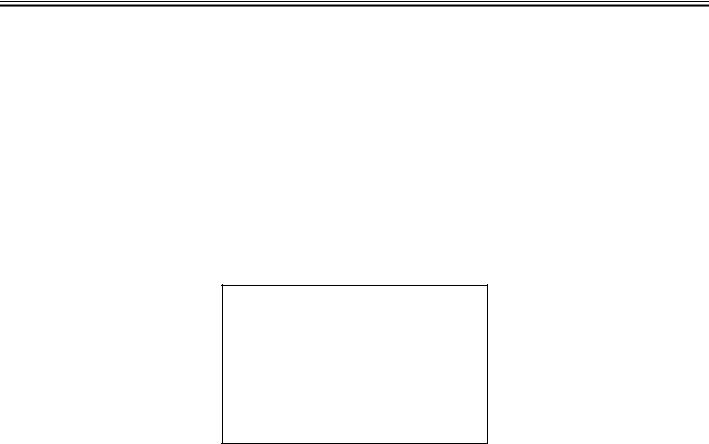
IMPORTANT MANUAL INFORMATION
EAU37230
TT-R50E/TT-R50EW
OWNER’S MANUAL ©2006 by Yamaha Motor Co., Ltd.
1st edition, April 2006 All rights reserved.
Any reprinting or unauthorized use without the written permission of Yamaha Motor Co., Ltd.
is expressly prohibited. Printed in China.

TABLE OF CONTENTS
SAFETY INFORMATION .................. |
1-1 |
Location of important labels ............ |
1-4 |
DESCRIPTION .................................. |
2-1 |
Left view .......................................... |
2-1 |
Right view ........................................ |
2-2 |
Controls and instruments................. |
2-3 |
INSTRUMENT AND CONTROL |
|
FUNCTIONS ....................................... |
3-1 |
Main switch ..................................... |
3-1 |
Handlebar switches ........................ |
3-1 |
Speed limiter ................................... |
3-2 |
Shift pedal ....................................... |
3-2 |
Brake lever ..................................... |
3-3 |
Brake pedal .................................... |
3-3 |
Fuel tank cap .................................. |
3-3 |
Fuel ................................................. |
3-4 |
Fuel tank breather hose .................. |
3-5 |
Fuel cock ........................................ |
3-5 |
Starter (choke) lever ....................... |
3-6 |
Seat ................................................ |
3-7 |
Sidestand ........................................ |
3-7 |
Starting circuit cut-off system ......... |
3-8 |
PRE-OPERATION CHECKS .............. |
4-1 |
Pre-operation check list .................. |
4-2 |
OPERATION AND IMPORTANT |
|
RIDING POINTS................................. |
5-1 |
Starting and warming up a cold |
|
engine ......................................... |
5-1 |
Starting a warm engine .................. |
5-2 |
Shifting ........................................... |
5-2 |
Engine break-in .............................. |
5-3 |
Parking ........................................... |
5-4 |
PERIODIC MAINTENANCE AND |
|
MINOR REPAIR ................................. |
6-1 |
PERIODIC MAINTENANCE ........... |
6-1 |
Periodic maintenance chart for the |
|
emission control system ............. |
6-2 |
General maintenance and |
|
lubrication chart .......................... |
6-3 |
Checking the spark plug ................. |
6-5 |
Engine oil ....................................... |
6-6 |
Cleaning the air filter element ........ |
6-8 |
Cleaning the spark arrester ............ |
6-9 |
Adjusting the carburetor ............... |
6-10 |
Adjusting the engine idling |
|
speed ........................................ |
6-11 |
Adjusting the throttle cable free |
|
play ........................................... |
6-11 |
Valve clearance ............................ |
6-12 |
Tires ............................................. |
6-12 |
Spoke wheels ............................... |
6-14 |
Accessories and replacement |
|
parts .......................................... |
6-14 |
Adjusting the brake lever free |
|
play ........................................... |
6-14 |
Adjusting the brake pedal free |
|
play ........................................... |
6-15 |
Checking the front and rear |
|
brake shoes .............................. |
6-16 |
Drive chain slack .......................... |
6-16 |
Cleaning and lubricating the |
|
drive chain ................................ |
6-18 |
Checking and lubricating the |
|
cables ....................................... |
6-19 |
Checking and lubricating the |
|
throttle grip and cable ............... |
6-19 |
Checking and lubricating the |
|
brake and shift pedals .............. |
6-19 |
Checking and lubricating the |
|
brake lever ................................ |
6-20 |
Checking and lubricating the |
|
sidestand .................................. |
6-20 |
Lubricating the swingarm |
|
pivots ........................................ |
6-20 |
Checking the front fork ................. |
6-21 |
Checking the steering .................. |
6-21 |
Checking the wheel bearings ....... |
6-22 |
Battery ......................................... |
6-22 |
Replacing the fuse ....................... |
6-24 |
Supporting the motorcycle ........... |
6-25 |
Front wheel .................................. |
6-25 |
Rear wheel ................................... |
6-27 |
Troubleshooting ........................... |
6-29 |
Troubleshooting chart .................. |
6-30 |

TABLE OF CONTENTS
MOTORCYCLE CARE AND |
|
STORAGE .......................................... |
7-1 |
Care ................................................ |
7-1 |
Storage ........................................... |
7-3 |
SPECIFICATIONS ............................. |
8-1 |
CONSUMER INFORMATION............. |
9-1 |
Identification numbers .................... |
9-1 |

 SAFETY INFORMATION
SAFETY INFORMATION
EAU39313
Safe riding
● Always make pre-operation
1checks. Careful checks may help prevent an accident.
●This motorcycle is designed for offroad use only, therefore, it is illegal to operate it on public streets, roads, or highways, even a dirt or gravel one. Off-road use on public lands may be illegal. Please check local regulations before riding.
●This motorcycle is designed to carry the operator only. No passengers.
●Many accidents involve inexperienced operators.
•Make sure that the operator is qualified and that you only lend your motorcycle to other qualified operators.
•Know your skills and limits. Staying within your limits may help you to avoid an accident.
●Many accidents have been caused by error of the motorcycle operator. A typical error made by the operator is veering wide on a turn due to EXCESSIVE SPEED or un-
dercornering (insufficient lean angle for the speed). Never travel faster than warranted by conditions.
●Ride cautiously in unfamiliar areas. You may encounter hidden obstacles that could cause an accident.
●The posture of the operator is important for proper control. The operator should keep both hands on the handlebar and both feet on the operator footrests during operation to maintain control of the motorcycle.
●Never ride under the influence of alcohol or other drugs.
●Be sure the transmission is in neutral before starting the engine.
Protective apparel
The majority of fatalities from motorcycle accidents are the result of head injuries. The use of a safety helmet is the single most critical factor in the prevention or reduction of head injuries.
● Always wear an approved helmet.
●Wear a face shield or goggles. Wind in your unprotected eyes could contribute to an impairment of vision that could delay seeing a hazard.
●The use of a jacket, heavy boots, trousers, gloves, etc., is effective in preventing or reducing abrasions or lacerations.
●Never wear loose-fitting clothes, otherwise they could catch on the control levers, footrests, or wheels and cause injury or an accident.
●Never touch the engine or exhaust system during or after operation. They become very hot and can cause burns. Always wear protective clothing that covers your legs, ankles, and feet.
Modifications
Modifications made to this motorcycle not approved by Yamaha, or the removal of original equipment, may render the motorcycle unsafe for use and may cause severe personal injury. Modifications may also make your motorcycle illegal to use.
1-1

 SAFETY INFORMATION
SAFETY INFORMATION
Loading and accessories
Adding accessories to your motorcycle can adversely affect stability and handling if the weight distribution of the motorcycle is changed. To avoid the possibility of an accident, use extreme caution when adding accessories to your motorcycle. Use extra care when riding a motorcycle that has added accessories. Here are some general guidelines to follow if adding accessories to your motorcycle:
Loading
●The weight of the operator must not exceed 40 kg (88 lb).
●Accessory weight should be kept as low and close to the motorcycle as possible. Make sure to distribute the weight as evenly as possible on both sides of the motorcycle to minimize imbalance or instability.
●Shifting weights can create a sudden imbalance. Make sure that accessories are securely attached to the motorcycle before riding. Check accessory mounts frequently.
● Never attach any large or heavy items to the handlebar, front fork, or front fender.
Accessories
Genuine Yamaha accessories have been specifically designed for use on this motorcycle. Since Yamaha cannot test all other accessories that may be available, you must personally be responsible for the proper selection, installation and use of non-Yamaha accessories. Use extreme caution when selecting and installing any accessories.
Keep these guidelines in mind for mounting accessories in addition to those provided under “Loading”.
●Never install accessories or that would impair the performance of your motorcycle. Carefully inspect the accessory before using it to make sure that it does not in any way reduce ground clearance or cornering clearance, limit suspension travel, steering travel or control operation.
•Accessories fitted to the handlebar or the front fork area can create instability due to improper
1-2
weight distribution or aerodynamic changes. If accessories are added to the handlebar or
front fork area, they must be as 1 lightweight as possible and should be kept to a minimum.
•Bulky or large accessories may seriously affect the stability of the motorcycle due to aerodynamic effects. Wind may attempt to lift the motorcycle, or the motorcycle may become unstable in cross winds.
•Certain accessories can displace the operator from his or her normal riding position. This improper position limits the freedom of movement of the operator and may limit control ability, therefore, such accessories are not recommended.
●Use caution when adding electrical accessories. If electrical accessories exceed the capacity of the motorcycle’s electrical system, an electric failure could result, which could cause a dangerous loss of engine power.

 SAFETY INFORMATION
SAFETY INFORMATION
Gasoline and exhaust gas
●GASOLINE IS HIGHLY FLAMMABLE:
1• Always turn the engine off when refueling.
•Take care not to spill any gasoline on the engine or exhaust pipe(s)/muffler(s) when refueling.
•Never refuel while smoking or in the vicinity of an open flame.
●Never start the engine or let it run for any length of time in a closed area. The exhaust fumes are poisonous and may cause loss of consciousness and death within a short time. Always operate your motorcycle in an area that has adequate ventilation.
●Always turn the engine off before leaving the motorcycle unattended and remove the key from the main switch. When parking the motorcycle, note the following:
•The engine and exhaust pipe(s)/ muffler(s) may be hot, therefore, park the motorcycle in a place
where pedestrians or children are not likely to touch these hot areas.
•Do not park the motorcycle on a slope or soft ground, otherwise it may fall over.
•Do not park the motorcycle near a flammable source (e.g., a kerosene heater, or near an open flame), otherwise it could catch fire.
●When transporting the motorcycle in another vehicle, make sure that it is kept upright and that the fuel cock(s) are turned to “ON” or “RES” (for vacuum type)/“OFF” (for manual type). If the motorcycle should lean over, gasoline may leak out of the carburetor or fuel tank.
●If you should swallow any gasoline, inhale a lot of gasoline vapor, or allow gasoline to get into your eyes, see your doctor immediately. If any gasoline spills on your skin or clothing, immediately wash the affected area with soap and water and change your clothes.
1-3
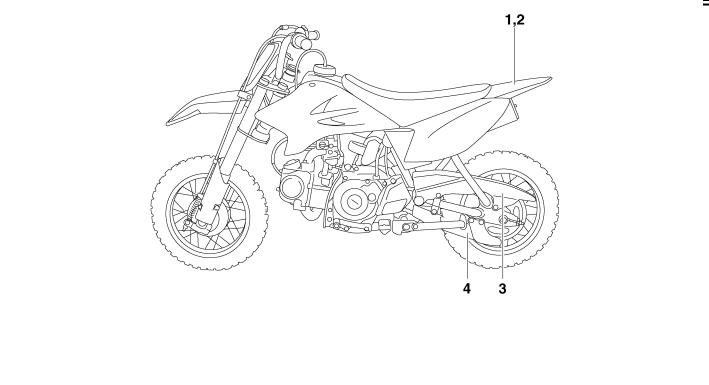
 SAFETY INFORMATION
SAFETY INFORMATION
EAU41370
Location of important labels
Please read the following important labels carefully before operating this vehicle.
For Canada |
1 |
|
|
1-4
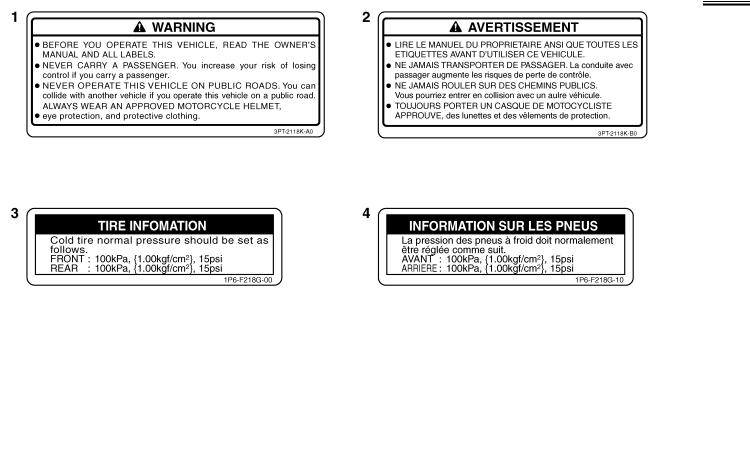
 SAFETY INFORMATION
SAFETY INFORMATION
For Canada
1
1-5
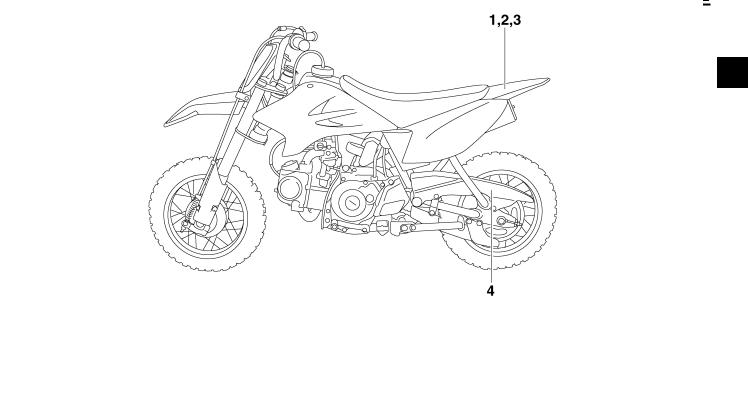
 SAFETY INFORMATION
SAFETY INFORMATION
Except for Canada
1
1-6
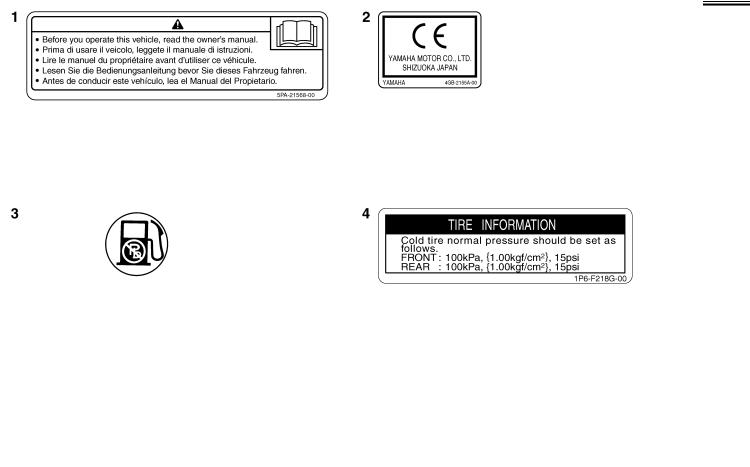
 SAFETY INFORMATION
SAFETY INFORMATION
Except for Canada
1
1-7
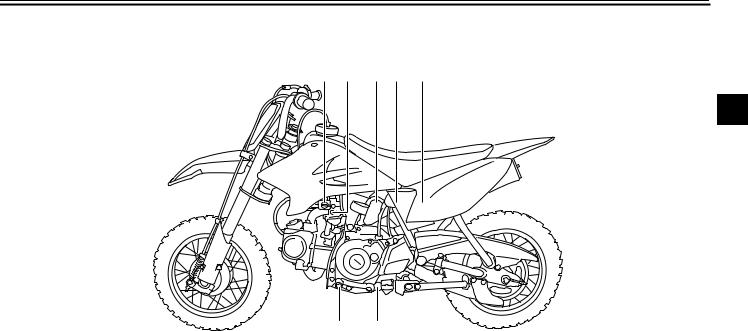
DESCRIPTION
EAU10410
Left view
1 2 3 4 5
2
7 6
1.Fuel cock (page 3-5)
2.Throttle stop screw (page 6-11)
3.Air filter element (page 6-8)
4.Fuse (page 6-24)
5.Battery (page 6-22)
6.Engine oil drain bolt (page 6-6)
7.Shift pedal (page 3-2)
2-1
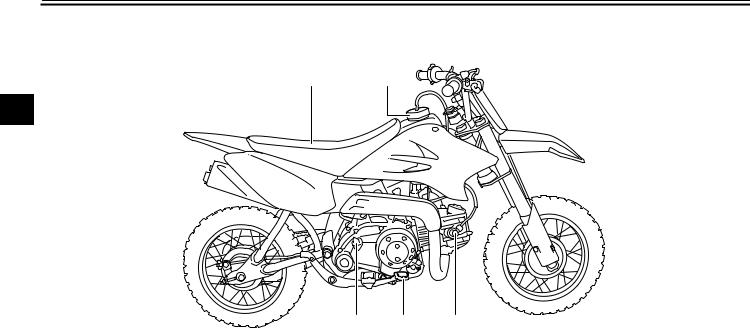
DESCRIPTION
EAU10420
Right view
1 2
2
5 4 3
1.Seat (page 3-7)
2.Fuel tank cap (page 3-3)
3.Spark plug cap (page 6-5)
4.Brake pedal (page 3-3)
5.Engine oil filler cap (page 6-6)
2-2
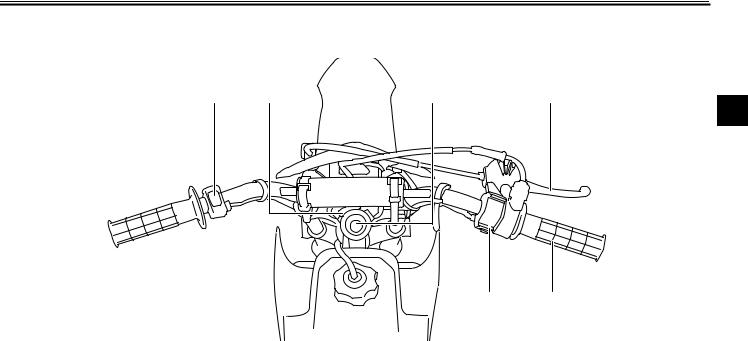
DESCRIPTION
EAU10430
Controls and instruments
1 |
2 |
3 |
4 |
|
|
|
2 |
6 5
1.Left handlebar switch (page 3-1)
2.Starter (choke) lever (page 3-6)
3.Main switch (page 3-1)
4.Brake lever (page 3-3)
5.Throttle grip (page 6-11)
6.Right handlebar switch (page 3-1)
2-3
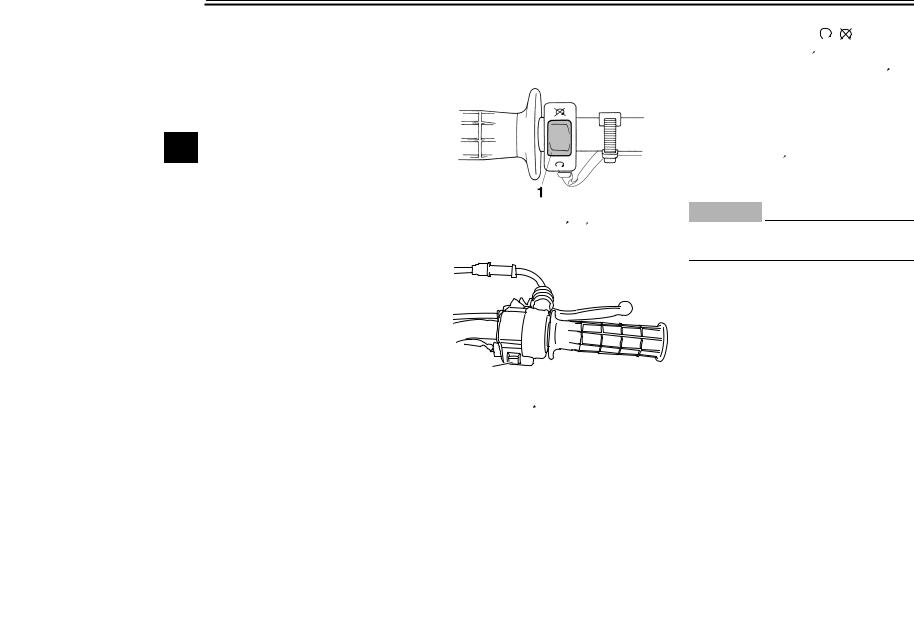
INSTRUMENT AND CONTROL FUNCTIONS
EAU40340
Main switch
3
The main switch controls the ignition system. The main switch positions are described below.
EAU10630
ON
All electrical systems are supplied with power, and the engine can be started. The key cannot be removed.
EAU10660
OFF
All electrical systems are off. The key can be removed.
Handlebar switches
Left
1. Engine stop switch “ /
/ ”
”
Right
EAU12346 |
EAU12660 |
Engine stop switch “ |
/ ” |
Set this switch to “ ” before starting the engine. Set this switch to “
” before starting the engine. Set this switch to “ ” to stop the engine in case of an emergency, such as when the vehicle overturns or when the throttle cable is stuck.
” to stop the engine in case of an emergency, such as when the vehicle overturns or when the throttle cable is stuck.
EAU12710
Start switch “ ”
”
Push this switch to crank the engine with the starter.
ECA10050
CAUTION:
See page 5-1 for starting instructions prior to starting the engine.
1
1. Start switch “ ”
”
3-1
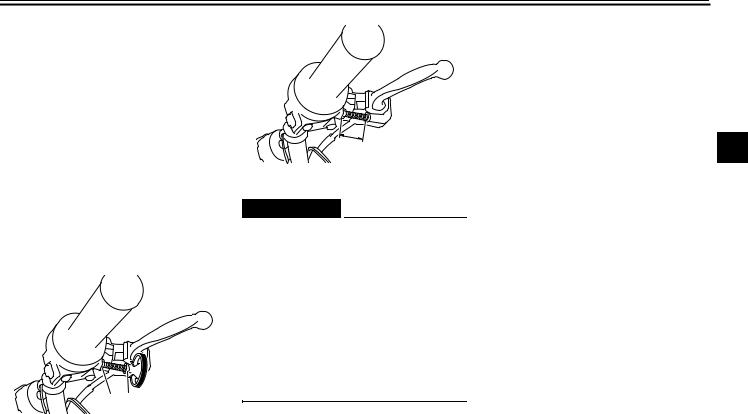
INSTRUMENT AND CONTROL FUNCTIONS
EAU39860
Speed limiter
Your motorcycle was delivered with an adjustable speed limiter. The speed limiter keeps the throttle from fully opening, even when the throttle grip is turned to the maximum.
1.Loosen the locknut.
2.To increase the maximum engine power available and the maximum speed of the motorcycle, turn the adjusting screw in direction (a). To decrease the maximum engine power available and the maximum speed of the motorcycle, turn the adjusting screw in direction (b).
(b)
1 2 (a)
1.Locknut
2.Adjusting screw
1
1. No more than 25 mm (0.98 in)
EWA14400
 WARNING
WARNING
Improper adjustment of the speed limiter and throttle could cause throttle cable damage or improper throttle operation. You could lose control, have an accident or be injured. Do not turn the adjusting screw out more than 25 mm (0.98 in) or the throttle cable could be damaged. Always make sure the throttle cable free play is adjusted to 3.0–5.0 mm (0.12–0.20 in). (See page 6-11.)
EAU39850
Shift pedal
3
1. Shift pedal
This motorcycle is equipped with a con- stant-mesh 3-speed transmission. The shift pedal is located on the left side of the engine. Neutral is at the bottom position.
3. Tighten the locknut.
3-2

INSTRUMENT AND CONTROL FUNCTIONS
EAU12890 |
EAU12941 |
EAU13180 |
Brake lever |
Brake pedal |
Fuel tank cap |
1 |
|
1 |
3
1
1. Brake lever
The brake lever is located at the right handlebar grip. To apply the front brake, pull the lever toward the handlebar grip.
1. Brake pedal
The brake pedal is on the right side of the motorcycle. To apply the rear brake, press down on the brake pedal.
1. Fuel tank cap
To remove the fuel tank cap, turn it counterclockwise, and then pull it off. To install the fuel tank cap, insert it into the tank opening, and then turn it clockwise.
EWA11090
 WARNING
WARNING
Make sure that the fuel tank cap is properly closed before riding.
3-3
